| Game facts | |
|---|---|
| players | 2 |
| time | 20-30minutes |
| designers | Marty Hale-Evans, Ron Hale-Evans |
| license | CC BY-SA |
| source | ludism.org/… |
This is an old revision of the document!
Table of Contents
Plans of Action
| Game facts | |
|---|---|
| players | 1 |
| time | 10-20minutes |
| designers | L. Edward Pulley |
| license | custom... |
| source | piecepack.org/… |
A Solitary Confinement game for the piecepack by L. Edward Pulley Version 1.1, January 19, 2004 Copyright © 2003 L. Edward Pulley For 1 (one) Player, of course; 10-20 Minutes playing time Equipment needed : 16 tiles, and all 24 coins from a standard piecepack.
(Please, don’t be intimidated by the length of this document. It is mostly graphics, with the rules really only covering one page, followed by a sample game so that all the game mechanics can be seen in action. Just stick with it and you will see that it is all quite simple. Thank you.)
Setup
Take the 16 tiles and place them in a 4×4 square, grid side up, as in example below.

This creates a playing grid of 64 spaces.
Now randomly place the 24 coins in the center of the grid, 6 across, 4 down, color side up, as in example 2. (I personally just put all the coins in a small box then draw them out one at a time. You may use whatever method you prefer, just so long as it is random.)
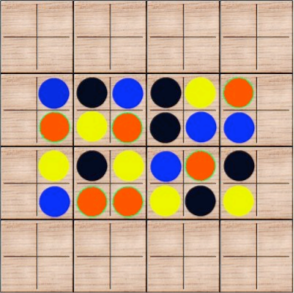
Your configuration of coins will most likely be different, but for learning purposes, you may want to set up everything like the example so that you can follow along.
The Goal
Using the following rules of movement, try to arrange the coins of matching colors so that all six coins of one color is lined up orthogonally with other coins of the same color. (For those without a dictionary nearby, that would be linked up by row or column, but not diagonally. Thank you “New Word of the Day” calendar.)
Rules of Movement
Individual coins can only move by Jumping over spaces in its row or column, regardless of whether there is a coin on them or not, and landing on an empty space. The number of matching colors in that row or column defines the number of spaces a coin Jumps, and must land in an empty space. If a coin is the only one in the row, it may only Jump one space. If there are two, it must Jump two spaces, no more, no less. The same rules continue for 3, 4, 5, or 6 coins.
A coin may not land on another coin.
If a tile is ‘fully loaded’, meaning that it has a coin on each space, there are two new movement options available to you.
- It may be Rotated 90º, 180º, or 270º.
- It may be Shifted orthogonally (there is that word again) in any direction to the next empty tile-space.
A tile may do one or the other, but not both, and once a tile is Rotated or Shifted, a coin must be moved from it. At no time do you have to Rotate or Shift a tile, it is completely optional.
And that is it. If you have any questions, hopefully the following sample plays will answer them.
Example Game
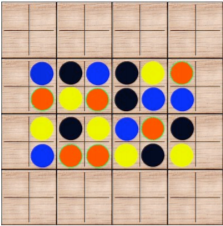
1 - Here is that sample setup again. The numbers don’t matter on the coins. Only the colors.

2 – Here a Red coin has made a Jump. It Jumped over two other spaces, because there are two Red coins in the row.

3 – Another two space Jump, this time a Blue coin.

4 – This time, one of the tiles (third from left, second tile down) was Rotated. It was able to be rotated because all four spaces were filled with coins.

5 – Since a coin must be moved from the tile after it Rotates, a Black coin made a two space Jump downwards.

6 – Another Rotation, this time the tile three over from the left, and three down.
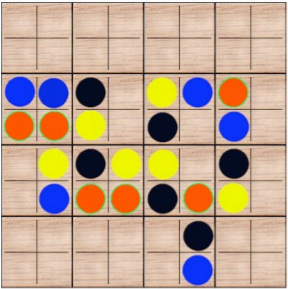
7 – Again, a coin must be moved from the tile after it rotates, a Blue coin made a two space Jump downwards, resting beneath the Black coin.

8 – Another Black coin makes a two space Jump, resulting in a three coin connection.
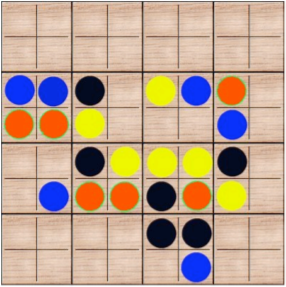
9 – Now a Yellow coin makes a three space Jump (since there are three Yellow coins in that row). This results in a three coin connection also.

10 – This time a Red coin Jumps over a space. Since it was the only coin in its column, it could only Jump one space.
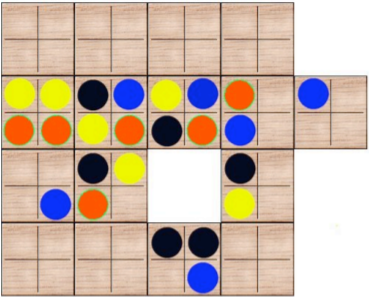
11 – A fully loaded tile has been Shifted to the next available tile-space at the end of its row. (yes, the Yellow coin on the tile two over/two down could jump the Red coin, making a connection of five coins, but it appears that this player didn’t see that move. How observant of you to notice it, though.)

12 – Just like after a Rotation, a coin must Jump after a Shift, and so the Red coin makes a three space jump. Notice that it jumped over three spaces, regardless of whether there was a coin on the space or not.

13 – Now the other Red coin from the Shifted tile has made a three space Jump. This is not a required move; only one coin must be moved, and after that moves may be made as desired. Here it results in a connection of three Red coins, but takes up the space that the Yellow coin could have used.

14 – Now a fully loaded tile has Shifted to the next available empty tile-space to the left.

15 – A Blue coin has made the required Jump.

16 – Now another tile has Shifted, this time taking the first available empty tile-space above it.
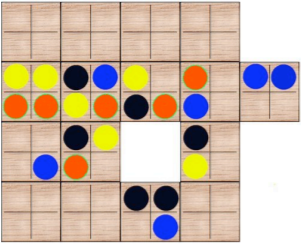
17 – A Yellow coin makes the required Jump, moving over three spaces to the left.

18 – A Blue coin has Jumped over three spaces to the left.

19 – Now a tile Shifts downward to the next available empty tile-space. Yes, this was the same tile that shifted a couple turns ago, but it now is fully loaded with a different set of coins, so this counts as a completely new Shift.
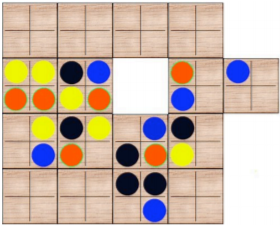
20 – A Yellow coin makes the required Jump, moving two spaces to the left.

21 – Now a Red coin has Jumped three spaces to the right. Notice that although there is an empty tile-space in the middle, you still count the two spaces that would be there. While a coin may not land in an empty tile-space, it can Jump over it, counting like it would as if there were a tile there.
That is the end of the sample play. It wasn’t a particularly well played game, but it should have presented you with most the possible situations that could occur.
How to Score Games
This is not intended to be a scored game, but rather more of a puzzle. There should always be a way to connect six coins in the required manner, and once you become good at the game, you should be able to make the connections with more than one color, or perhaps all four. While I haven’t done the proof, I feel fairly certain that all possible set-ups are solvable.
For those who want a way to score, the easiest way would be to accomplish the goal in the least amount of moves. Some set-ups will be easier than others, and so if you wish to have a set way to compare your scores to others, perhaps you should use a set-up that you can tell others about so that they can try it also.
Variations
For more of a challenge, you can try solving for all four colors at the same time, instead of just one. This was the original version of the game, and the preferred version of the author.
Practice
Here is a sample Puzzle Set-up. Try to solve it with the least number of moves, then compare with others to see how you did. Then, if you feel ambitious, try to solve it for all the colors. Both of these puzzles may be found to be somewhat simple, but then again, they are only intended as practice. Enjoy!
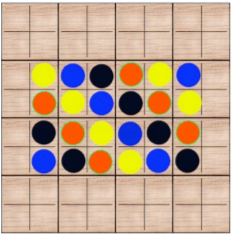
(I would like to acknowledge that this game was inspired by Sid Sackson’s Fields of Action, which was in turn inspired by Claude Souci’s Lines of Action These are two wonderful games that I would encourage anyone to take the time to learn and play, and I believe they would both be adaptable to piecepack. There also is a bit of Sackson’s Sly in there, as that is what inspired my initial set-up concept.)
Licensing
Copyright © 2003 by L. Edward Pulley. Permission is granted to copy, distribute, display, and perform the work, to make derivative works, and to make commercial use of the work, as long as credit is given to the original author, and if you alter, transform, or build upon this work, you may distribute the resulting work only under a license identical to this one.
These rules were written in English, and are currently best read and used in English. A copy of the rules is available in Pig Latin upon request. (Just kidding about the Pig Latin.)
eseThay ulesray ereway ittenwray inway Englishway, andway areway urrentlycay estbay eadray andway usedway inway Englishway. Away opycay ofway ethay ulesray isway availableway inway igPay atinLay uponway equestray. (ustJay iddingkay aboutway ethay igPay atinLay.)
